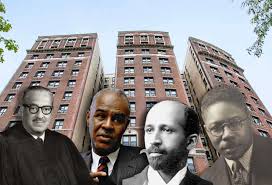
Good Morning POU!

In 1918, his company continuing to sell homes to African Americans, John Nail was disappointed as he read about continued lynchings and voter suppression in black newspapers and in the syndicated columns of Ida B. Wells. He had participated in the 1917 Negro Silent Protest Parade in Harlem to protest violence against African Americans, walking with Walter White and James Weldon Johnson. In 1921, as he was returning hundreds of thousands of dollars (millions today) to Hannah Elias in profits, the race riots in Greenwood hit the papers.
On June 10, the New York Age, Harlem’s paper of record, carried the headline on its front page: Oklahoma Whites Attempt to Destroy Entire Negro Section. 75 Dead, Both Races, Many Wounded. In the months after the riots, a handful of African American survivors from Tulsa, showed up in Harlem: Nail helped them get settled and found them apartments.
Harlem soon became a destination for the black elite, with Madame C.J. Walker’s family moving to the neighborhood in 1910 and Robert Reed Church’s son Thomas Church moving there in 1919.
Many of the elite – professionals and clergymen who were descendants of old New York families – lived in the Stanford White homes on 138th and 139th Streets. Poorer Harlemites nicknamed the blocks “Strivers Row.”

Other professionals lived in apartments along the Golden Edge, 110 Street facing Central Park, in apartments that had been the residences of Jewish families.
Well to do and successful entertainers preferred to live in a section that was once part of Washington Heights but that blacks had renamed Sugar Hill. It was on a high bluff that ran north from 145th to 155th Street west of Colonial Park. One of the most prestigious addresses was 580 St. Nicholas Avenue, where singer and actress Ethel Waters and other entertainers lived. Another, 409 Edgecombe Avenue, a luxurious apartment house with a marble lobby built originally for whites, was home to “smart people with small incomes,” among them three members of the NAACP: Walter White, Roy Wilkins and Thurgood Marshall.
Philip Payton, founder of the now defunct Afro American Realty Company, also continued to buy and manage Harlem real estate for black tenants, founding the Philip A. Payton Jr. Company, known for its PAP logo. He even ventured outside the city to Long Island.
By 1914, The Outlook wrote that three-quarters of the black population of New York City, including all blacks of prominence, lived in Harlem; it called Payton “the father of his Negro community.” The success of Payton’s enterprise could be seen in the neighborhood of 13 West 131st Street, the house he had bought for himself and his wife Maggie in 1903. The entire street was white in 1900; by the time of the 1915 New York State census, the block was almost completely inhabited by blacks.
Philip Payton closed his largest deal in July 1917, a sale of six apartment houses for about $1.5 million, the largest sale of housing for blacks to that time. The buildings were renamed after prominent blacks in America: Crispus Attucks, Toussaint L’Ouverture, Phyllis Wheatley, Paul Laurence Dunbar, Frederick Douglass, and Booker T. Washington. The black population in Harlem had reached upwards of 70,000.
Payton died of liver cancer a month later at his country house in Allenhurst, New Jersey; he was 41. His younger brother Edward S. Payton, who had served as vice-president of Afro-American Realty, had passed even earlier, in 1912, at the age of 30. The Philip A. Payton Jr. Company survived after him, managing numerous African-American apartments at least until 1922.
By 1925, Nail and Associates owned and managed around fifty apartment complexes and had an annual income of $1 million. They also helped to develop Harlem by funding the Harlem branch of the YMCA, helping small businesses in the area, and building up Harlem’s local bank.
John Nail became the wealthiest and most influential black realtor in New York City. He held seats on numerous state and local boards, including the Real Estate Board of New York and the Housing Committee of New York where in each case he was the only black member. His advice was solicited by President Herbert Hoover’s Commission on Housing. Nail also contributed to the Harlem community through charities, political influence, and organizations aimed at uplifting the community including the New York branches of the National Association for the Advancement of Colored People (NAACP) and the National Urban League.
John Nail envisioned Harlem to be the new capital of the black middle class, an idea that seemed likely in the 1920s. When the depression hit Harlem, Nail and Parker Associates went bankrupt in 1933. Nail tried to start successor companies but was never able to see his goals accomplished. By the 1930s, Harlem had become an area of teeming tenements filled by working class African Americans rather than an area of individually owned homes. Nail and Payton’s vision did not materialize in the way they wanted, but it did result in black Harlem.
John E. Nail died on March 5, 1947 in New York City.

